Galleries
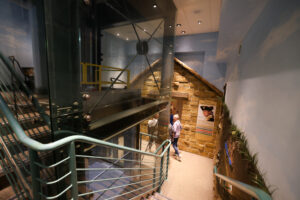
Cook’s Early Years
Travel back in time to learn about James Cook’s life as a child and a young man. Learn about the Cook family living in the ancient village of Marton and visit an artistic reconstruction of his birthplace cottage interior where you can listen to a conversation between a young James Cook and his mother, Grace.
See a model of Cook’s father’s famous cottage in Great Ayton and learn about young James’s school years and how his first employment in Staithes led to his introduction to the shipyards of Whitby and his training as a seaman.
The gallery has information about life during the age of Enlightenment and the historic background of the era through displays of objects both historic and modern, graphic panels and pieces of reproduction costume representing the clothes worn by members of society of the time.
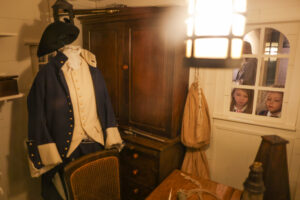
Cook in the Royal Navy and Life at Sea
Discover the sights, sounds and smells of life aboard ship in the 18th century. Learn about the typical seaman’s experiences of daily life illustrated by nautical object displays, reproduction 18th century naval uniforms and interactive hands on activities. These include a glimpse into the Captain’s Cabin on the famous HM Bark Endeavour and a chance to recreate a square meal aboard ship with food from the ships’ stores!
Learn about James Cook’s life as an able seaman in the Royal Navy and his introduction to surveying and chart making whilst in Canada.
As we start to uncover more about Cook’s personal life and family, peek into a small showcase displaying a handbag made from fabric from the wedding dress of his wife, Elizabeth.
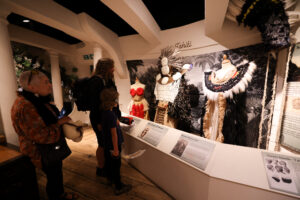
First Voyage
James Cook had risen to the rank of Lieutenant by the time he was commissioned to set sail on HM Bark Endeavour to observe the Transit of Venus in Tahiti in 1768. Discover the amazing voyage of discovery that this lead to and learn about the places and indigenous people that Cook and his crew encountered in Tahiti, New Zealand and Australia.
Cooks exciting first great voyage is brought to life through vibrant displays of Natural History specimens from Australia and New Zealand, breath taking Maori carvings and examples of indigenous Aboriginal tools, weapons and artwork including items from the Museum’s original Victorian collections.
These displays showcase the landmark discoveries, collections and illustrations made by the scientists, such as Sir Joseph Banks and artists who accompanied Cook on the voyage.
Graphic panels and engaging interactive activities tell the story of this iconic voyage and visitors can even try their hand at learning the ‘Middlesbrough Haka’ in traditional Maori style!
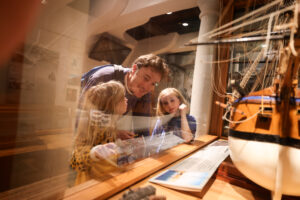
Second Voyage
Continuing the story of James Cook on his second great voyage.
Commissioned by the British government with advice from the Royal Society, this expedition was designed to circumnavigate the globe as far south as possible to finally determine whether there was any great southern landmass, or Terra Australis. Cook had been promoted to Commander on his return from the first voyage and he captained the HMS Resolution which set sail in 1772.
From the mysterious Easter Island to the frozen Southern Ocean, explore the places Cook visited through displays of beautiful specimens from the Museum’s Natural History collection and handmade cultural objects from the Polynesian Islands.
Demonstrating how the crew kept warm in freezing Antarctic temperatures there are reproduction costumes on display and also a film presentation to watch about this remarkable voyage around the globe.
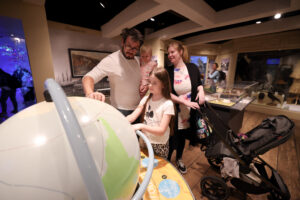
Third Voyage
James Cook’s third voyage of discovery was commissioned by the Admiralty to search for the fabled North West Passage at the top of North America.
Again, on board HMS Resolution, Cook set sail in 1776 sailing towards and around the coast of South America to then progress northwards where he surveyed yet more previously unchartered coastlines.
Intriguing displays of Natural History, World Cultures and reproduction costume tell the story of Cook’s encounters with indigenous peoples from settlements in the Alaskan and Russian far North.
The tale of James Cook’s death in Hawaii in 1779 is told with a large diorama of the scene as well as reproductions of marine uniform and traditional Hawaiian costume. Also on display is a rare printed textile which dramatically illustrates Cook’s final moments.
Meet our famous polar bear, get up close to amazing North American animals and trace all three of Cook’s famous voyages on an interactive globe.
Also on display is a showcase of beautiful contemporary craftworks kindly donated by the people of the Cook Islands and a there is a film presentation available in which indigenous people around the world comment on their own opinions of Cook and his legacy.
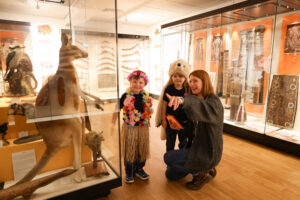
Walkabout Gallery
The Walkabout gallery contains objects kindly donated to the Museum from the Australian Aboriginal Arts Board and items from the museum’s original Victorian collections, this gallery holds part of the largest collection of Indigenous Australian Aboriginal artwork outside the National museums.
Alongside incredible specimens of native Australian wildlife, the stories and legends of the land and its people are told through a vibrant and thought-provoking narrative.
This gallery is opened to the public on certain days in the school holidays but can be made available to group or private visits by appointment.